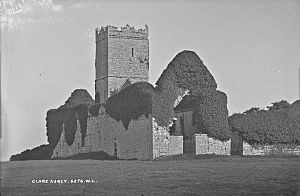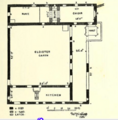Clare Abbey facts for kids
Quick facts for kids Clare Abbey |
|
|---|---|
 |
|
| Location | Clarecastle, County Clare, Ireland |
| Built | 1189 |
| Reference no. | 197 |
| Lua error in Module:Location_map at line 420: attempt to index field 'wikibase' (a nil value). | |
Clare Abbey, also known as Clareabbey, is an old ruined Augustinian monastery. It is found near the town of Ennis in County Clare, Ireland. The abbey sits along the Fergus River, about a mile north of Clarecastle. It was built in 1189 and was the biggest and most important Augustinian monastery in County Clare.
Contents
What is the History of Clare Abbey?
Clare Abbey was first called the "Abbey of St. Peter and St. Paul at Kilmony." It was founded in 1189 by Domnall Mór Ua Briain, who was the king of Thomond. This abbey was given to a group of priests called Augustinian Canons. It became the most important Augustinian monastery in County Clare. Other Augustinian monasteries nearby included Canon Island Abbey, Inchicronan Priory, Killone Nunnery, and the Abbey at Kilshanny.
Who Were the Augustinian Canons?
The Canons Regular were priests from Italy. They followed the rules of St. Augustine. Their main job was to help people in local churches. They lived a simple life, much like the people they served. These Canons fit in well with Irish life in the Middle Ages. By the 1200s, they were the largest group of religious orders in Ireland.
Why Was Clare Abbey Built Here?
Old documents mention the name "Kilmony," which means "the church on the bog." This suggests that Clare Abbey was built where an older church once stood. The only signs of an older building are a special stone called a bullaun and a stone carving. The monastery was built on land that stretched into the River Fergus flood plain. In 1900, an archaeologist named Thomas Johnson Westropp said the abbey was in a grassy area. This area was often flooded by the river. He thought the site was chosen because it was a sacred place. This also points to an earlier church being there.
What Happened at Clare Abbey?
In 1278, Clare Abbey was the site of a famous battle. This battle was part of a civil war between Toirdhealbhach Mór Ó Briain and Thomas de Clare. A leader named Donallbeg O'Brien surprised Mahon O'Brien and his followers. They were staying at the abbey and trying to leave quickly. Donallbeg's group attacked them.
A medieval story called Caithréim Thoirdhealbhaigh (Wars of Torlough) describes what happened. It says that many soldiers, women, children, and servants were captured. They were all killed in a bog nearby. This event became a well-known saying among the clans.
What Happened to the Abbey Later?
In the 1200s, two important clans in County Clare, the O’Briens and the Macnamaras, chose new burial places. They started using Ennis Friary and Quin Abbey. Over time, many local leaders stopped supporting the Augustinian monasteries. The buildings began to fall apart.
After the dissolution of the monasteries in 1543, King Henry VIII of England gave the abbey and its lands to the Barons of Ibrackan. The monks seemed to have stayed at the abbey until about 1650.
What Does Clare Abbey Look Like Today?
Clare Abbey is on the west bank of the Fergus River. It is about a mile south of Ennis. Today, the abbey ruins include a church with a bell tower. There are also several other buildings to the south and east of the church. These buildings surround a cloister, which is an open area.
Clare Abbey is a bit unusual for an Augustinian monastery because it does not have a west range. The church has one aisle and is made up of a long nave and chancel. A tower separates these two parts. The church was built in the late 1100s. The other buildings were added in the 1400s. The church was originally about 39 meters (128 feet) long and 9.5 meters (31 feet) wide. Some important features are three windows from the 1400s with special stone patterns called tracery.
When archaeologist Thomas Westropp visited in 1886, he saw that the bell tower had no stairs. He also saw a large tomb with no writing on it. He noted that many loose stones were fixed and repaired in 1898 and 1899. He also described a well-preserved east window, tower, and other buildings. The oldest tombs he could read were from the 1600s.
Images for kids



